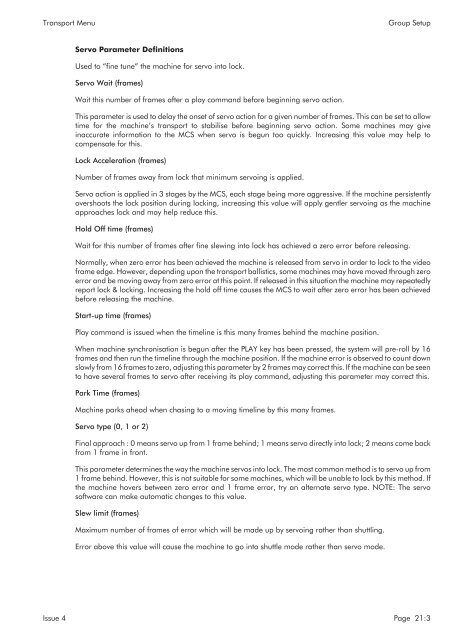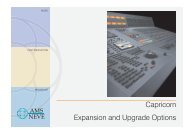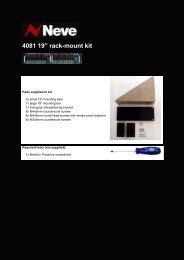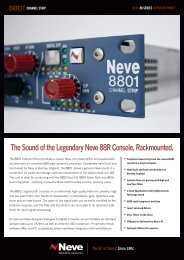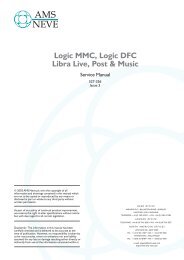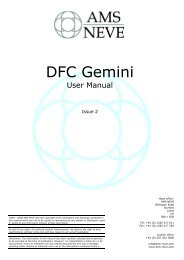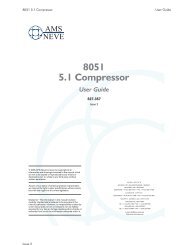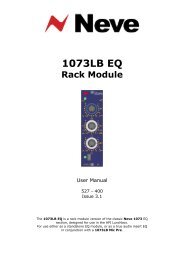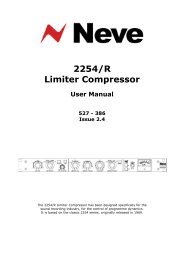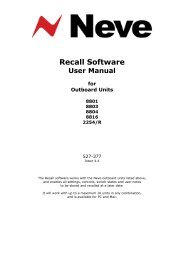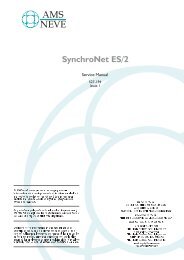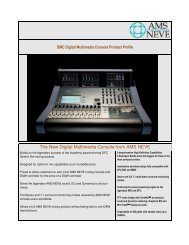MMC User Manual - AMS Neve
MMC User Manual - AMS Neve
MMC User Manual - AMS Neve
Create successful ePaper yourself
Turn your PDF publications into a flip-book with our unique Google optimized e-Paper software.
Transport Menu<br />
Group Setup<br />
Servo Parameter Definitions<br />
Used to “fine tune” the machine for servo into lock.<br />
Servo Wait (frames)<br />
Wait this number of frames after a play command before beginning servo action.<br />
This parameter is used to delay the onset of servo action for a given number of frames. This can be set to allow<br />
time for the machine’s transport to stabilise before beginning servo action. Some machines may give<br />
inaccurate information to the MCS when servo is begun too quickly. Increasing this value may help to<br />
compensate for this.<br />
Lock Acceleration (frames)<br />
Number of frames away from lock that minimum servoing is applied.<br />
Servo action is applied in 3 stages by the MCS, each stage being more aggressive. If the machine persistently<br />
overshoots the lock position during locking, increasing this value will apply gentler servoing as the machine<br />
approaches lock and may help reduce this.<br />
Hold Off time (frames)<br />
Wait for this number of frames after fine slewing into lock has achieved a zero error before releasing.<br />
Normally, when zero error has been achieved the machine is released from servo in order to lock to the video<br />
frame edge. However, depending upon the transport ballistics, some machines may have moved through zero<br />
error and be moving away from zero error at this point. If released in this situation the machine may repeatedly<br />
report lock & locking. Increasing the hold off time causes the MCS to wait after zero error has been achieved<br />
before releasing the machine.<br />
Start-up time (frames)<br />
Play command is issued when the timeline is this many frames behind the machine position.<br />
When machine synchronisation is begun after the PLAY key has been pressed, the system will pre-roll by 16<br />
frames and then run the timeline through the machine position. If the machine error is observed to count down<br />
slowly from 16 frames to zero, adjusting this parameter by 2 frames may correct this. If the machine can be seen<br />
to have several frames to servo after receiving its play command, adjusting this parameter may correct this.<br />
Park Time (frames)<br />
Machine parks ahead when chasing to a moving timeline by this many frames.<br />
Servo type (0, 1 or 2)<br />
Final approach : 0 means servo up from 1 frame behind; 1 means servo directly into lock; 2 means come back<br />
from 1 frame in front.<br />
This parameter determines the way the machine servos into lock. The most common method is to servo up from<br />
1 frame behind. However, this is not suitable for some machines, which will be unable to lock by this method. If<br />
the machine hovers between zero error and 1 frame error, try an alternate servo type. NOTE: The servo<br />
software can make automatic changes to this value.<br />
Slew limit (frames)<br />
Maximum number of frames of error which will be made up by servoing rather than shuttling.<br />
Error above this value will cause the machine to go into shuttle mode rather than servo mode.<br />
Issue 4 Page 21:3


